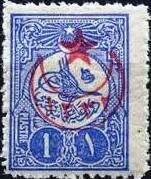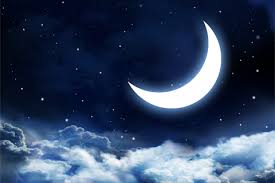Stamp: overprint on Internal post stamps 1909 (Turkey 1916)
overprint on Internal post stamps 1909 (Turkey 1916)
16 September (Turkey ) within release 1916 War Issues Overprinted With 5 Edge Star & Crescent Insi goes into circulation Stamp overprint on Internal post stamps 1909 face value 1 Turkish piastre
| Stamp overprint on Internal post stamps 1909 in catalogues | |
|---|---|
| Michel: | Mi: TR 452ICa |
| Stanley Gibbons: | Sg: TR 706 |
Stamp is square format.
Type I: The top of Coat of Arms pointing passed the half moonAlso in the issue 1916 War Issues Overprinted With 5 Edge Star & Crescent Insi:
- Stamp - overprint on post stamps 1892 face value 10;
- Stamp - overprint on post stamps 1892 face value 20;
- Stamp - overprint on post stamps 1892 face value 1;
- Stamp - overprint on post stamps 1892 face value 2;
- Stamp - overprint on post stamps 1892 face value 5;
- Stamp - overprint on Newspapers stamps of 1894 face value 10;
- Stamp - overprint on Newspapers stamps of 1894 face value 20;
- Stamp - overprint on Newspapers stamps of 1894 face value 5;
- Stamp - overprint on surcharged post stamps 1897 face value 5;
- Stamp - overprint on Newspapers stamps of 1897 face value 5;
- Stamp - overprint on Internal post stamps 1901 face value 5;
- Stamp - overprint on Internal post stamps 1901 face value 10;
- Stamp - overprint on Internal post stamps 1901 face value 20;
- Stamp - overprint on Internal post stamps 1901 face value 1;
- Stamp - overprint on Internal post stamps 1901 face value 2;
- Stamp - overprint & surcharged on Internal post stamps 1901 face value 10;
- Stamp - overprint & surcharged on Internal post stamps 1901 face value 10;
- Stamp - overprint on Internal post stamps 1901 face value 25;
- Stamp - overprint on Internal post stamps 1901 face value 50;
- Stamp - overprint on Internal Newspapers stamps of 1901 face value 5;
- Stamp - overprint on Internal Newspapers stamps of 1901 face value 10;
- Stamp - overprint on Internal Newspapers stamps of 1901 face value 20;
- Stamp - overprint on Internal Newspapers stamps of 1901 face value 1;
- Stamp - overprint on Internal Newspapers stamps of 1901 face value 2;
- Stamp - overprint on External post stamps 1901 face value 5;
- Stamp - overprint on External post stamps 1901 face value 10;
- Stamp - overprint on External post stamps 1901 face value 20;
- Stamp - overprint on External post stamps 1901 face value 1;
- Stamp - overprint on External post stamps 1901 face value 2;
- Stamp - overprint & surcharge on External post stamps 1901 face value 5;
- Stamp - overprint & surcharge on External post stamps 1901 face value 10;
- Stamp - overprint on External post stamps 1901 face value 25;
- Stamp - overprint on External Newspapers stamps of 1901 face value 5;
- Stamp - overprint on External Newspapers stamps of 1901 face value 10;
- Stamp - overprint on External Newspapers stamps of 1901 face value 20;
- Stamp - overprint on External Newspapers stamps of 1901 face value 1;
- Stamp - overprint on Internal post stamps 1905 face value 5;
- Stamp - overprint on Internal post stamps 1905 face value 20;
- Stamp - overprint on Internal post stamps 1905 face value 1;
- Stamp - overprint on Internal post stamps 1905 face value 2;
- Stamp - overprint on Internal post stamps 1905 face value 2½;
- Stamp - overprint & surcharged on Internal post stamps 1905 face value 10;
- Stamp - overprint & surcharged on Internal post stamps 1905 face value 10;
- Stamp - overprint on Internal post stamps 1905 face value 25;
- Stamp - overprint on Internal post stamps 1905 face value 50;
- Stamp - overprint on Newspapers stamps of 1905 face value 5;
- Stamp - overprint on Newspapers stamps of 1905 face value 10;
- Stamp - overprint on Newspapers stamps of 1905 face value 20;
- Stamp - overprint on Newspapers stamps of 1905 face value 1;
- Stamp - overprint on External post stamps 1906 face value 10;
- Stamp - overprint on External post stamps 1906 face value 20;
- Stamp - overprint on External post stamps 1906 face value 1;
- Stamp - overprint on Internal post stamps 1908 face value 2½;
- Stamp - overprint & surcharged on Internal post stamps 1908 face value 10;
- Stamp - overprint & surcharged on Internal post stamps 1908 face value 10;
- Stamp - overprint on Internal post stamps 1908 face value 25;
- Stamp - overprint & surcharged on Internal post stamps 1908 face value 25;
- Stamp - overprint on Internal post stamps 1908 face value 50;
- Stamp - overprint on Newspapers stamps of 1908 face value 5;
- Stamp - overprint on External post stamps 1908 face value 2;
- Stamp - overprint on Constitution stamps of 1908 face value 5;
- Stamp - overprint on Internal post stamps 1909 face value 5;
- Stamp - overprint on Internal post stamps 1909 face value 10;
- Stamp - overprint on Internal post stamps 1909 face value 20;
- Stamp - overprint on Internal post stamps 1909 face value 1;
- Stamp - overprint on Internal post stamps 1909 face value 2;
- Stamp - overprint on Internal post stamps 1909 face value 2½;
- Stamp - overprint on Internal post stamps 1909 face value 5;
- Stamp - overprint on External post stamps 1909 face value 1;
- Stamp - overprint on External post stamps 1909 face value 2;
- Stamp - overprint on Newspapers stamps of 1909 face value 5;
- Stamp - overprint on Internal post stamps 1913 face value 5;
- Stamp - overprint on Internal post stamps 1913 face value 20;
- Stamp - overprint on Internal post stamps 1913 face value 1;
- Stamp - overprint on Internal post stamps 1913 face value 2;
- Stamp - overprint & surcharged on Internal post stamps 1913 face value 10;
- Stamp - overprint on Internal post stamps 1913 face value 25;
- Stamp - overprint on Internal post stamps 1913 face value 50;
- Stamp - overprint on External post stamps 1913 face value 1;
- Stamp - overprint on Adrianople Stamps of 1913 face value 10;
- Stamp - overprint on Adrianople Stamps of 1913 face value 20;
- Stamp - overprint on Adrianople Stamps of 1913 face value 40;
- Stamp - overprint on National Fest of 1914 face value 60;
- Stamp - overprint on Post Office stamps of 1916 face value 5;
- Stamp - overprint and surcharge on Postage Due stamps of 1913 face value 10;
- Stamp - overprint and surcharge on Postage Due stamps of 1913 face value 20;
- Stamp - overprint and surcharge on Postage Due stamps of 1913 face value 40;
- Stamp - overprint and surcharge on Postage Due stamps of 1913 face value 40;
- Stamp - overprint on Post Office stamps of 1916 face value 5;
- Stamp - overprint on Internal post stamps 1905 face value 2½;
- Stamp - overprint on Internal post stamps 1905 face value 2½;
- Stamp - Black overprint on External post stamps 1906 face value 1;
- Stamp - overprint on Internal post stamps 1905 face value 1;
- Stamp - overprint on Internal post stamps 1905 face value 1;
- Stamp - overprint on Internal post stamps 1905 face value 1;
- Stamp - overprint on Internal post stamps 1909 face value 1;
- Stamp - overprint on Newspapers stamps of 1905 face value 1;
- Stamp - Red overprint on External post stamps 1906 face value 1;
Stamp overprint on Internal post stamps 1909 it reflects the thematic directions:
A crescent shape (/ˈkrɛsənt/, UK also /ˈkrɛzənt/) is a symbol or emblem used to represent the lunar phase (as it appears in the northern hemisphere) in the first quarter (the "sickle moon"), or by extension a symbol representing the Moon itself.
World War I or the First World War (28 July 1914 – 11 November 1918), also known as the Great War, was a global conflict between two coalitions: the Allies (or Entente) and the Central Powers. Main areas of conflict included Europe and the Middle East, as well as parts of Africa and the Asia-Pacific. There were important developments in weaponry including tanks, aircraft, artillery, machine guns, and chemical weapons. One of the deadliest conflicts in history, it resulted in an estimated 30 million military casualties, plus another 8 million civilian deaths from war-related causes and genocide. The movement of large numbers of people was a major factor in the deadly Spanish flu pandemic.
The Moon is Earth's only natural satellite. It orbits at an average distance of 384,400 km (238,900 mi), about 30 times the diameter of Earth. Tidal forces between Earth and the Moon have over time synchronized the Moon's orbital period (lunar month) with its rotation period (lunar day) at 29.5 Earth days, causing the same side of the Moon to always face Earth. The Moon's gravitational pull – and to a lesser extent, the Sun's – are the main drivers of Earth's tides.
A star is a luminous spheroid of plasma held together by self-gravity. The nearest star to Earth is the Sun. Many other stars are visible to the naked eye at night; their immense distances from Earth make them appear as fixed points of light. The most prominent stars have been categorised into constellations and asterisms, and many of the brightest stars have proper names. Astronomers have assembled star catalogues that identify the known stars and provide standardized stellar designations. The observable universe contains an estimated 1022 to 1024 stars. Only about 4,000 of these stars are visible to the naked eye—all within the Milky Way galaxy.
Sultan is a title of Arabic origin for Islamic rulers who are monarchs. The title often corresponds to that of a king.




